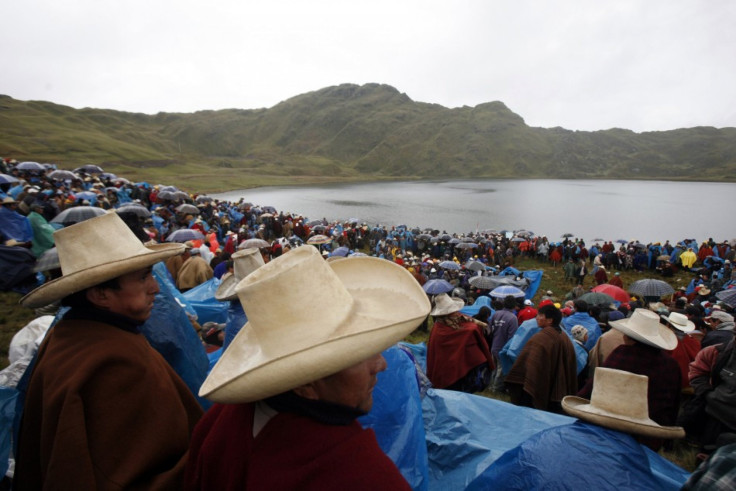Peru in 'State of Emergency' over Gold Mine Protests

(REUTERS) -- Peruvian President Ollanta Humala declared a state of emergency late on Sunday to quell protests against Newmont Mining's $4.8 billion Conga gold mine project that have hobbled the region of Cajamarca for 11 days.
Humala, a former army officer, chided leaders of the environmental protest as intransigent after weeks of mediation efforts failed. His decree allows the military to help police reopen roads, schools and hospitals shuttered for days by rallies and marches against the proposed mine.
It was the first time in Humala's young presidency that he has used extraordinary powers to defuse a social conflict over mining in Peru, where disputes in some 200 communities across the country threaten to delay billions of dollars in planned mine and oil projects.
Every possible means has been exhausted to establish dialogue and resolve the conflict democratically, but the intransigence of local and regional leaders has been exposed - not even the most basic agreements could be reached to ensure social peace and the re-establishment of public services, he said on state television.
Humala, a former leftist, won the presidency in June on promises to steer more social spending to rural towns to help calm social conflicts over natural resources while assuring companies their investments would be safe in Peru's surging economy.
He has said the project by U.S.-based Newmont would benefit all of Peru. It is the largest mining investment in the country's history, with gold deposits worth about $15 billion at current prices.
The impasse has highlighted Humala's struggle to neutralize Peru's polarized political environment and govern as a moderate who can simultaneously help the poor and please big business.
Humala has urged dialogue to solve the dispute, but nearly a week ago the government was forced to ask Newmont to temporarily halt work on the Conga mine after the protests turned violent. Since then protesters have continued to march and demand the government permanently cancel the project.
Prime Minister Salomon Lerner negotiated on Sunday for hours with leaders of the protest, who say the mine will hurt water supplies and cause pollution.
But Lerner could not reach an accord, prompting Humala to invoke a state of emergency - a tool that his predecessor, former President Alan Garcia, frequently used to quash protests.
CANETE CLASH
The state of emergency decree came after a protest against a prison expansion project spiralled out of control on Friday in the coastal city of Canete, killing one protester in a clash with police that appeared to catch the government off guard.
Though the death was unrelated to hundreds of environmental disputes nationwide that Humala has promised to end, it was the first stemming from a protest since he took office in July.
A local environmental group, regional mayors, and the president of the region of Cajamarca say the Conga mine would displace a string of alpine lakes with reservoirs and hurt farmers. Other protesters worry about not getting what they say is their share of direct economic benefits from the mine.
Protesters have also criticized Humala for moving too far to the right, embracing foreign investment, and supporting the Conga project, which would generate thousands of jobs and enormous tax revenues.
Some political analysts have worried that if Humala did not act soon with a firm hand he would be continually tested by left-wing protesters upset that he is governing as a moderate.
The government has urged Newmont to set up funds for social and environmental programs in a bid to win support for the mine.
Newmont has said its environment plan for the mine, which was approved a year ago by the government, meets the highest standards in the mining industry. It also runs extensive community outreach programs out of its nearby Yanacocha gold mine, some of which were developed after a mercury spill in 2000 that angered local residents.
The Conga project, which Newmont owns with Peruvian precious metals miner Buenaventura, would produce 580,000 to 680,000 ounces of gold a year and open in 2014.
It has gold deposits worth about $15 billion at current prices and sits 13,800 feet (4,200 metres) high in the Andes, about 600 miles (990 km) north of Lima.
© Copyright Thomson Reuters 2024. All rights reserved.






















